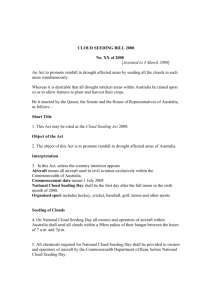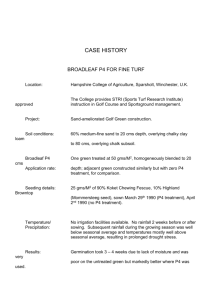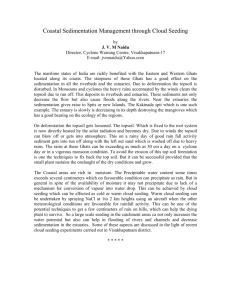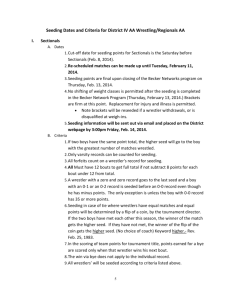Seeding Time and Method for Winterfat in the Semiarid Region
advertisement
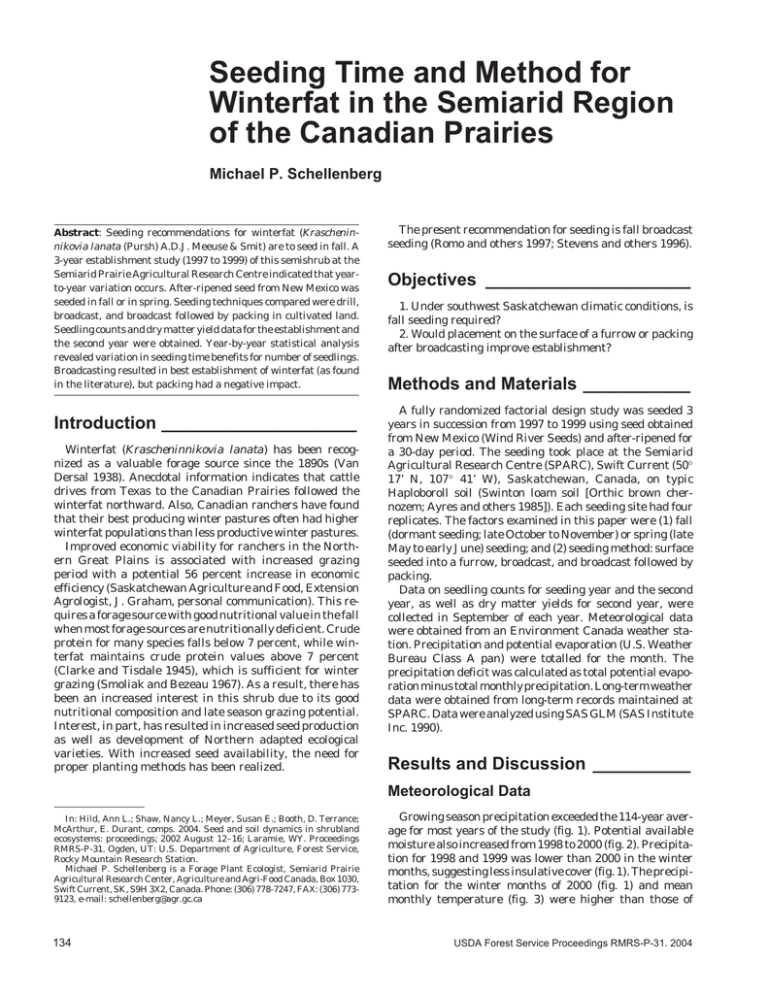
Seeding Time and Method for Winterfat in the Semiarid Region of the Canadian Prairies Michael P. Schellenberg Abstract: Seeding recommendations for winterfat (Krascheninnikovia lanata (Pursh) A.D.J. Meeuse & Smit) are to seed in fall. A 3-year establishment study (1997 to 1999) of this semishrub at the Semiarid Prairie Agricultural Research Centre indicated that yearto-year variation occurs. After-ripened seed from New Mexico was seeded in fall or in spring. Seeding techniques compared were drill, broadcast, and broadcast followed by packing in cultivated land. Seedling counts and dry matter yield data for the establishment and the second year were obtained. Year-by-year statistical analysis revealed variation in seeding time benefits for number of seedlings. Broadcasting resulted in best establishment of winterfat (as found in the literature), but packing had a negative impact. Introduction ____________________ Winterfat (Krascheninnikovia lanata) has been recognized as a valuable forage source since the 1890s (Van Dersal 1938). Anecdotal information indicates that cattle drives from Texas to the Canadian Prairies followed the winterfat northward. Also, Canadian ranchers have found that their best producing winter pastures often had higher winterfat populations than less productive winter pastures. Improved economic viability for ranchers in the Northern Great Plains is associated with increased grazing period with a potential 56 percent increase in economic efficiency (Saskatchewan Agriculture and Food, Extension Agrologist, J. Graham, personal communication). This requires a forage source with good nutritional value in the fall when most forage sources are nutritionally deficient. Crude protein for many species falls below 7 percent, while winterfat maintains crude protein values above 7 percent (Clarke and Tisdale 1945), which is sufficient for winter grazing (Smoliak and Bezeau 1967). As a result, there has been an increased interest in this shrub due to its good nutritional composition and late season grazing potential. Interest, in part, has resulted in increased seed production as well as development of Northern adapted ecological varieties. With increased seed availability, the need for proper planting methods has been realized. The present recommendation for seeding is fall broadcast seeding (Romo and others 1997; Stevens and others 1996). Objectives _____________________ 1. Under southwest Saskatchewan climatic conditions, is fall seeding required? 2. Would placement on the surface of a furrow or packing after broadcasting improve establishment? Methods and Materials ___________ A fully randomized factorial design study was seeded 3 years in succession from 1997 to 1999 using seed obtained from New Mexico (Wind River Seeds) and after-ripened for a 30-day period. The seeding took place at the Semiarid Agricultural Research Centre (SPARC), Swift Current (50∞ 17’ N, 107∞ 41’ W), Saskatchewan, Canada, on typic Haploboroll soil (Swinton loam soil [Orthic brown chernozem; Ayres and others 1985]). Each seeding site had four replicates. The factors examined in this paper were (1) fall (dormant seeding; late October to November) or spring (late May to early June) seeding; and (2) seeding method: surface seeded into a furrow, broadcast, and broadcast followed by packing. Data on seedling counts for seeding year and the second year, as well as dry matter yields for second year, were collected in September of each year. Meteorological data were obtained from an Environment Canada weather station. Precipitation and potential evaporation (U.S. Weather Bureau Class A pan) were totalled for the month. The precipitation deficit was calculated as total potential evaporation minus total monthly precipitation. Long-term weather data were obtained from long-term records maintained at SPARC. Data were analyzed using SAS GLM (SAS Institute Inc. 1990). Results and Discussion __________ Meteorological Data In: Hild, Ann L.; Shaw, Nancy L.; Meyer, Susan E.; Booth, D. Terrance; McArthur, E. Durant, comps. 2004. Seed and soil dynamics in shrubland ecosystems: proceedings; 2002 August 12–16; Laramie, WY. Proceedings RMRS-P-31. Ogden, UT: U.S. Department of Agriculture, Forest Service, Rocky Mountain Research Station. Michael P. Schellenberg is a Forage Plant Ecologist, Semiarid Prairie Agricultural Research Center, Agriculture and Agri-Food Canada, Box 1030, Swift Current, SK, S9H 3X2, Canada. Phone: (306) 778-7247, FAX: (306) 7739123, e-mail: schellenberg@agr.gc.ca 134 Growing season precipitation exceeded the 114-year average for most years of the study (fig. 1). Potential available moisture also increased from 1998 to 2000 (fig. 2). Precipitation for 1998 and 1999 was lower than 2000 in the winter months, suggesting less insulative cover (fig. 1). The precipitation for the winter months of 2000 (fig. 1) and mean monthly temperature (fig. 3) were higher than those of USDA Forest Service Proceedings RMRS-P-31. 2004 Seeding Time and Method for Winterfat in the Semiarid Region of the Canadian Prairies Schellenberg 140 Precipitation (mm) 120 100 80 60 40 20 0 Jan Feb Mar Apr May July June Aug Sept Oct Nov Dec Month 1998 2000 1999 114 year mean Figure 1—Monthly precipitation for 1998 to 2000 and 114-year mean. previous years. Mean monthly temperatures in the fall of 1997 (fig. 3) were warmer than the following years, resulting in premature germination and seedling death prior to spring 1998, thus resulting in better 1998 spring seedling establishment (table 1). Time of Seeding Spring or fall seeding appears to be year dependant (table 1) with first-year seedling counts, indicating no multiple-year benefits for either spring or fall seeding. With increasing annual growing season precipitation (figs. 1 and 2), fall seeding failed to provide a benefit (table 1). In the wettest year (2000), no difference between spring or fall seeding occurred for seedling establishment. Plant counts for the year following establishment indicate that the effect of fall seeding continues beyond the seedling year (table 1). The dry matter yield per plant was better for fall-seeded plants (table 1). The additional time for growth from earlier germination is most likely the primary factor. Method of Seeding Furrows provide a microenvironment with potentially increased moisture (Bellotti and Blair 1989) and decreased wind. However, these potential benefits were negated by burial of surface-seeded winterfat as indicated by lower plant counts and dry matter yield (table 2). Broadcasting and packing failed to result in increased seedling numbers, although there may have been benefit for dry matter yield Precipitation deficit (mm) 0 -50 Table 1—Dry matter yields, plant counts for first year and second year of establishment for time of seeding factor for three seeding years. -100 -150 1997– 1998 -200 -250 -300 May June July Aug Month 2000 1999 1998 Figure 2—Precipitation deficit (Pan “A”) evaporationprecipitation) for 1998 to 2000 growing seasons. USDA Forest Service Proceedings RMRS-P-31. 2004 Sept Seeding site 1998– 1999 1999– 2000 Year 1 fall plant count (m–2) Fall seeding Spring seeding 2.4 5.8a 2.2a 1.5 1.3 1.4 Year 2 plant count (m–2) Fall seeding Spring seeding nab nab 1.5 1.2 1.4 1.8 20.2a 9.4 14.3a 8.4 nab nab Year 2 dry matter yield (g plant–1) Fall seeding Spring seeding a b Statistically significant (P > 0.05). na = data not available. 135 Seeding Time and Method for Winterfat in the Semiarid Region of the Canadian Prairies Mean monthly temperature (degrees C) Schellenberg 15 10 5 0 -5 -10 -15 -20 -25 Jan Feb Mar May April June July Aug Sept Oct Nov Dec Month 1997 1998 1999 2000 Figure 3—Mean monthly minimum temperature. (table 2). The increased dry matter yield may have resulted from improved moisture retention or decreased seedling competition, as a result of lower number of seedlings. Further research is needed to determine exact cause. Conclusions ____________________ Benefits of fall or spring seeding for winterfat seedling establishment depended on the prevailing environmental conditions during the establishment year. The variation in year could be due to available moisture. The availability of water, winter temperatures, and available insulative cover appear to affect the optimum time of seeding. Further research is required to establish the relationship of water and temperature. Table 2—Dry matter yields, plant counts for first year and second year of establishment for seed method factor for three seeding years. 1997– 1998 Seeding site 1998– 1999 1999– 2000 Year 1 fall plant count (m–2) Furrow Broadcast Broadcast and packed 2.0a 5.8 4.6b 0.9a 2.3 2.3 0.4a 2.0 1.6b Year 2 plant count (m–2) Furrow Broadcast Broadcast and packed nac nac nac 0.8a 1.9 2.0 0.6a 2.2 2.0 Year 2 dry matter yield (g plant–1) Furrow Broadcast Broadcast and packed 12.8 14.6 17.1 11.6 10.6 11.8 nac nac nac a Statistically significant (P > 0.05) difference from broadcast treatments determined with single degree of freedom contrast. b Statistically significant (P > 0.05) difference from broadcast alone treatment determined with single degree of freedom contrast. c na = data not available. 136 Fall seeding did result in greater per plant dry matter production, although dry matter yields were unaffected by seeding method. Manipulation of microclimate using furrows did not result in increased seedling establishment. Broadcasting of winterfat seed resulted in better seedling establishment compared to seeding in a furrow, but packing following broadcasting tended to have a negative impact on seedling numbers. Acknowledgments ______________ This work was possible with funding support from the Saskatchewan Agricultural Development Fund and Agriculture and Agri-Food Canada. Technical support from J. Bolton, B. Hedger, and numerous summer students, especially C. Neufeld, was greatly appreciated. Poster development was with the assistance of D. Schott. References _____________________ Ayres, K. W.; Acton, D. F.; Ellis, J. G. 1985. The soils of Swift Current map 725 Saskatchewan. Publ. 56. Saskatoon, SK: University of Saskatchewan, Saskatchewan Institute of Pedology. 22 p. Bellotti, W. D.; Blair, G. J. 1989. The influence of sowing method on perennial grass establishment. II. Seedbed microenvironment, germination and emergence. Australian Journal Agricultural Research. 40: 313–321. Clarke, S. E.; Tisdale, E. W. 1945. The chemical composition of native forage plants of southern Alberta and southwestern Saskatchewan. Tech. Bull. 46. Ottawa, Ontario: Dominion of Canada, Department of Agriculture. Romo, J. T.; Booth, D. T.; Bai, Y.; Hou, J.; Zabek, C. 1997. Seedbank requirement and cold tolerance of winterfat seedlings: an adapted forage for the Canadian prairies. Saskatchewan Agricultural Development Fund Report prepared by: Department of Crop Science and Plant Ecology, University of Saskatchewan, Saskatoon, SK. 101 p. SAS Institute, Inc. 1990. SAS users guide: statistics. Cary, NC: SAS Institute, Inc. Smoliak, S.; Bezeau, L. M. 1967. Chemical composition and in vitro digestibility of range forage plants of the Stipa-Bouteloua prairie. Canadian Journal of Plant Science. 47: 161–167. USDA Forest Service Proceedings RMRS-P-31. 2004 Seeding Time and Method for Winterfat in the Semiarid Region of the Canadian Prairies Stevens, R.; Jorgensen, K. R.; Young, S. A.; Monsen, S. B. 1996. Forb and shrub seed production guide for Utah. Logan: Utah State University Extension Service. 51 p. USDA Forest Service Proceedings RMRS-P-31. 2004 Schellenberg Van Dersal, W. R. 1938. Native woody plants of the United States: their erosion-control and wildlife value. Washington, DC: U.S. Government Printing Office. 362 p. 137
